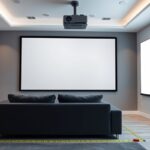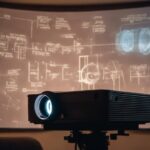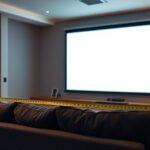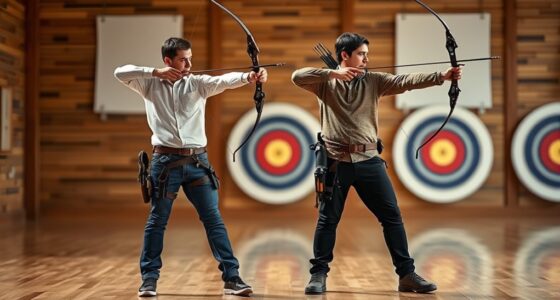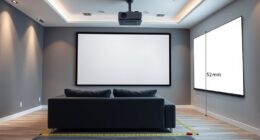To calculate the ideal projector distance, start by knowing your screen size and throw ratio. Divide the screen size in inches by 12, then multiply the result by the throw ratio to find the perfect distance. For example, a 100-inch screen with a 1.5:1 throw ratio needs about 12.5 feet of space. Proper placement ensures a sharp, bright image with minimal distortion—keep exploring to learn how to fine-tune your setup even further.
Key Takeaways
- Use the projector’s throw ratio to determine distance by dividing the desired screen width by 12 and multiplying by the throw ratio.
- Ensure the projector is placed perpendicular and level to the screen to avoid keystone distortion and maintain image quality.
- Match the projector’s distance with screen size requirements to prevent blurriness or dimming, optimizing brightness and clarity.
- Larger screens require greater distance; calculate accordingly to fill the screen without image loss.
- Proper placement minimizes keystone correction, ensuring a sharp, undistorted image for the best viewing experience.

Choosing the right distance between your projector and screen is essential for achieving a clear, sharp image. When you position your projector, the projection angle plays a significant role in how well the image appears and how evenly it fills the screen. The projection angle refers to the tilt or slope of the projector’s beam as it projects onto the surface. If the angle is too steep or too shallow, it can cause distortion or keystone effects, which distort the image and reduce picture quality. To avoid this, you need to consider the ideal projection angle for your setup, ensuring the projector is aligned properly to produce a rectangular, undistorted image.
Another critical factor to consider is screen size. Larger screens require the projector to be placed at a greater distance to fill the surface without losing image clarity. Conversely, smaller screens need less distance, allowing for a more compact setup. The key is to find a balance where the projector is neither too close nor too far, which depends on the projector’s throw ratio. The throw ratio guides you in determining the suitable distance based on your desired screen size. For example, if your projector has a throw ratio of 1.5:1, and your screen measures 100 inches diagonally, you’d need to position the projector approximately 12.5 feet away (since 100 inches divided by 12 inches per foot equals about 8.33 feet, multiplied by the throw ratio of 1.5).
Getting this distance right ensures the image is bright, sharp, and properly scaled. If you place the projector too close, the image may be overly large or blurry, and if it’s too far, the picture could appear dim or pixelated. Additionally, the projection angle should be considered to prevent distortion. When the projector is placed at an awkward angle, the image can become trapezoidal, which affects clarity and viewing experience. To minimize this, aim to position your projector so that it’s as level and perpendicular to the screen as possible, maintaining a consistent projection angle. Proper projector placement reduces the need for keystone correction and helps achieve optimal image quality.
Frequently Asked Questions
How Does Ambient Light Affect Optimal Projector Placement?
Ambient illumination and light intensity directly impact your ideal projector placement. When there’s high ambient light, you need to position your projector closer to the screen or choose a brighter projector to guarantee clear image quality. Reducing ambient light or controlling light sources nearby helps improve contrast and visibility. So, adjust your projector’s distance based on the light conditions in your environment to get a sharp, vivid picture.
Can Wall Color Change the Recommended Projector Distance?
Yes, wall paint can change the recommended projector distance. Bright or dark wall colors affect the projected image’s brightness and clarity, which influences your projector alignment. When your wall paint absorbs or reflects light differently, you may need to adjust the distance to get a sharp, clear picture. Test different distances to find the best projector alignment, ensuring the image remains vivid and in focus despite the wall color.
What Are the Differences Between Short-Throw and Long-Throw Projectors?
Short-throw projectors have a low throw ratio, allowing you to place them close to the screen while still producing a large image, making them ideal for small rooms. Long-throw projectors have a high throw ratio, requiring more distance to create a big image, suitable for large spaces. When choosing, consider projector brightness and throw ratio to guarantee clear images without shadows or glare, fitting your room size.
How Do Screen Size and Resolution Influence Projector Positioning?
Imagine trying to fit a giant screen into a tiny room—your projector’s position becomes a comedy of errors. Larger screen sizes demand more distance to project a clear image, while higher resolutions need precise placement for sharp visuals. You’ll find that bigger screens require you to step back, and ultra-high resolutions ask for careful alignment. Balance these factors, or risk your presentation turning into a pixelated disaster.
Are There Portable Projectors With Flexible Distance Requirements?
Yes, there are portable options with flexible setups. Many portable projectors feature adjustable throw distances, allowing you to project clearly from various distances without strict placement requirements. Look for models with short-throw or ultra-short-throw capabilities, which can be positioned close to the screen or wall, providing convenience and versatility. These projectors are ideal when you need mobility and adaptability for different spaces or setups.
Conclusion
Now that you’ve learned how to calculate the perfect projector distance, you’ll notice how easily everything aligns once you put it into practice. It’s almost like the universe conspired to make your setup seamless, isn’t it? When your projector and screen meet just right, everything seems to fall into place naturally. So go ahead, experiment a little—you might find that the right distance was waiting for you all along, just like this perfect setup.



